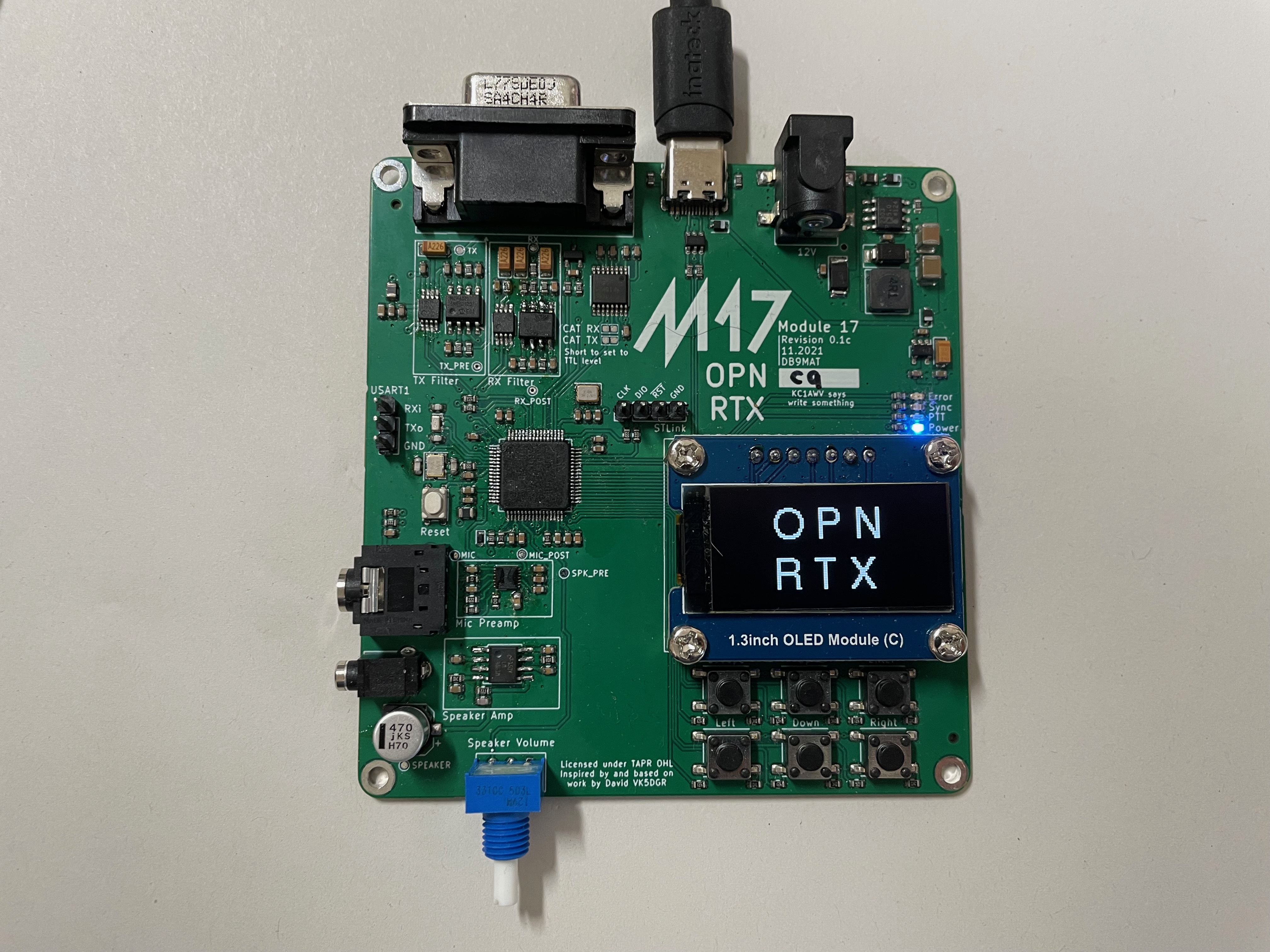Module 17
Welcome to Module 17!
This project provides a standalone smart microphone that transforms any 9600 baud capable transceiver into an M17 compatible radio. It is based on a STM32F4 microcontroller and is designed to run the OpenRTX firmware. Audio and PTT connectivity is given through a "Kenwood 2 Pin" compatible connector (2.5 and 3.5mm audio jacks).
Several boards of various revisions have been built. While the changes between r0.1a and r0.1b were quite drastic, r0.1c and d are only minor revisions, mainly for parts availability. The pinout, baseband filters and components are considered stable and will (probably) not change in future revisions, ensuring software compatibility. Revision 0.1d boards can be ordered partially or even fully assembled at JLCPCB with the manufacturing data in this repository. The volume knob and digital potentiometers are only available through Mouser/Digikey, but JLCPCB can acquire them through their global sourcing program.
Basic OpenRTX support is already given, but the UI needs an overhaul for Module 17.
Flashing
To flash, hold the "Escape" button down while plugging in USB (or pressing the reset switch) to wait in DFU mode.
You can then follow standard OpenRTX flashing instructions for the "mod17" target if you have dfu-util installed.
Once flashing is complete, reset the board to boot into the newly flashed application.
Revisions
Revision 0.1a
This is the initial prototyping revision and not yet designed with "ease of use and enclosing" in mind. Its main purpose is getting OpenRTX up and running on the hardware and providing a proof of concept.
Errata of Revision 0.1a
- Do not install R23 (1k5 pull-up on USB D+) as the STM32F4 has an integrated pull-up
- Replace C3 and C6 with 18pF, otherwise Y1 starts too slow during USB DFU
- Short BOOT0 on pin 94 to PB8 on pin 95 to be able to use SW4 in software
- The 2.5mm mono jack used for the Kenwood 2-pin speaker mic has the "sleeve" connection where stereo plugs have the "ring". This means that the speaker mic has no GND connection. To fix this, add a bodge wire to the outer shell of the mono jack to GND. Next revisions will use a stereo jack with shorted ring and sleeve connections.
Revision 0.1b
Fixed some bugs:
- Changed audio amp from LM386 to LM4861MX
- Mic amplifier changed from LMV341 to MAX9814 (with an AGC)
- Fixed Kenwood connector
- Fixed baseband processing at U6/U7
- C3/C6 value change from 22 to 18p
- Changed micro from STM32F407VETx to -405RGTx
- Added TPS5431 DC/DC converter IC
- Added MAX3232 and
CAT_TX/CAT_RXat DE9 connector
Revision 0.1c
- Reduced audio amplifier gain (R3 value change 510k->22k)
- Fixed
RADIO_RXbaseband DC bias
Revision 0.1d
- Changed supply voltage for U6 and U7 (baseband filter Op-Amps) to 5V and replaced MCP602 with MCP6002 as the former ICs are not rail2rail capable on their input
- Fixed
CAT_TXandCAT_RXsolder jumpers - Fixed volume knob direction
- Replaced PSU with in-stock parts
- Replaced MAX3232 with simple 5V/3.3V level shifters as most, if not all, radios use either 5V or 3.3V TTL instead of RS232
- Replaced STM32F405RGT6 with GD32F405RGT6 - these ICs are pin and code compatible
Future revisions
Future revisions will feature at least additional power supply options and will be designed with an enclosure in mind.
Acknowledgments
This project is inspired by David Rowe's SM1000 Codec2 smart mic and shares some of its circuitry. The analog baseband filtering is inspired by the MMDVM_RPT_Hat and is a simplified version of F0DEI's original filter design that is used with great success at many MMDVM repeater sites.
License
Module 17 is licensed under the TAPR Open Hardware License
